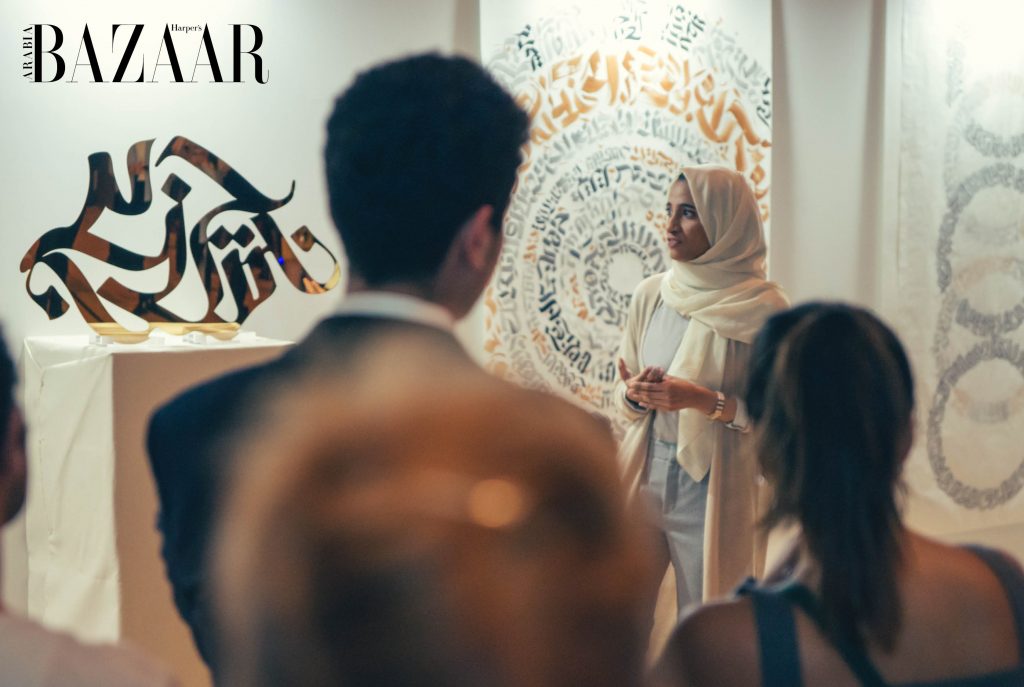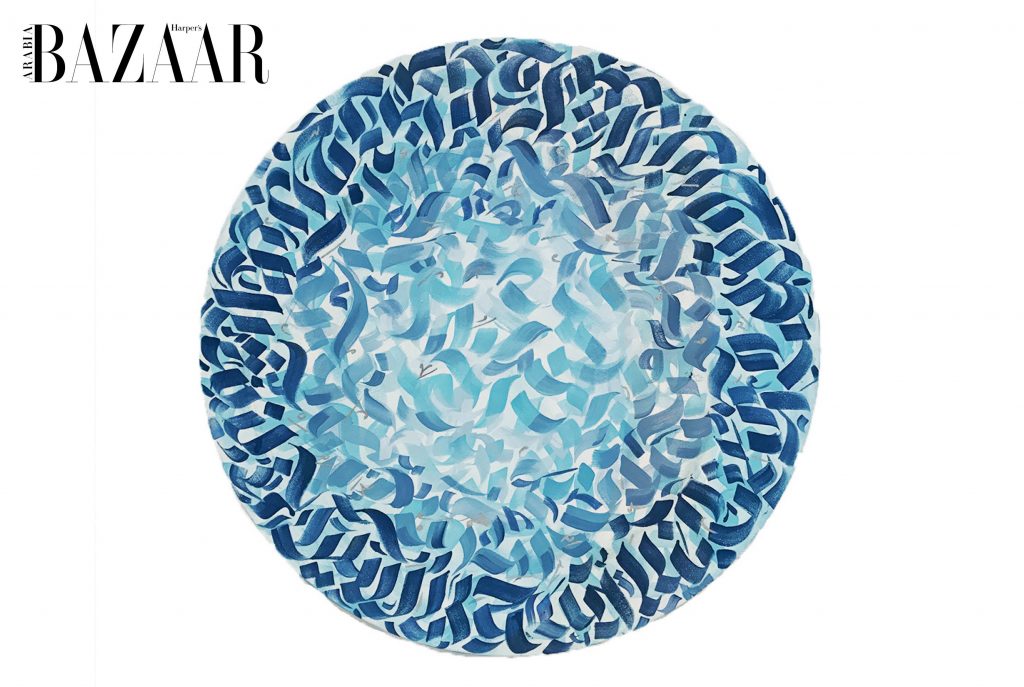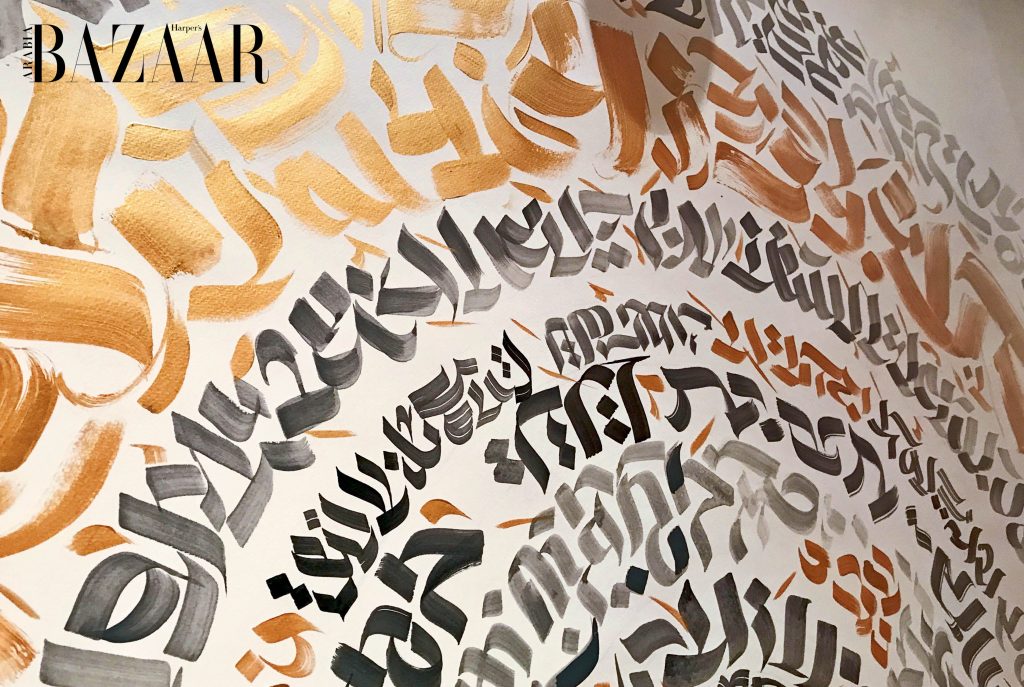
Introducing Calligraffiti: Meet The Saudi Artist Merging Traditional Arabic Calligraphy with Contemporary Street Art
Mawadah Muhtasib seamlessly fuses together two artistic worlds, combining elements of her heritage with a modern-day aesthetic…
Mawadah Muhtasib is well on the way to becoming a prominent name in the global art scene after a number of acclaimed international commissions. Most recently, her work was included as part of UNESCO’s Arabic Language Day exhibition at its headquarters in Paris. The Arabic Language, a Bridge Between Civilizations presentation showcased 18 artists from 13 different countries and was supported by the Sultan Bin Abdulaziz Al-Saud Foundation. Mawadah exhibited a piece with six geometric patterns inspired by the traditional Islamic mashrabiya window screens that are common on the older buildings in her home city of Jeddah, each grid symbolising one of six family values: compassion, trust, unity, integrity, loyalty and equality. The designs for the grids were given a modern twist by incorporating letters and strokes from a unique calligraphy-meets-graffiti typeface that Mawadah created back in 2013 at just 17 years of age – a typeface that is starting to give her a celebrity-like status in the region.

“Calligraffiti is a combination of calligraphy and graffiti,” explains Mawadah, who has shown as part of international exhibitions in London, Kuala Lumpur, New York and Detroit. “It is traditional calligraphy, whether Arabic, English or Chinese, combined with modern techniques that stand out and are constantly evolving. Calligraffiti art has been around since 2002 and is practiced by artists all over the world, and in 2013, I created the first reverse Arabic calligraffiti script, which I have been practicing ever since.”

It’s quite something to create your very own stunningly decorative typeface at such a young age. “I grew up in an artistic family, my father is a photographer and my mother is a ceramic artist, which inspired me to get involved with art,” Mawadah, 26, tells Bazaar. “I have always been fascinated by the complexity and beauty of traditional Arabic calligraphy, it is one of the richest forms of knowledge and art reflected visually and conceptually. I started my graffiti journey at a young age in 2012 when graffiti art was at its peak, I wanted a form of art that had no boundaries, was very expressive, and was not limited to a specific space. From this concept, I developed a new style that combined graffiti art with calligraphy.”

Mawadah picked up her first prestigious commission in 2014, while still at university. She was invited by the office of Crown Prince of Dubai Shaikh Hamdan Bin Mohammad Bin Rashid Al Maktoum to be one of 150 graffiti artists from around the globe to create the longest graffiti scroll in the world. She also participated in the ‘Create & Inspire’ prize in Brazil, and was the youngest artist to ever win. An art residency in New York followed in 2017, during which time the United Nations selected her work to be exhibited at the International UN Bazaar. She has since shown at a number of Saudi and international exhibitions, collaborated with luxury brands including Louis Vuitton and Mont Blanc and was a jury member for the Purificación García contest that took place at Princess Nourah Bint Abdulrahman University in Riyadh in 2020.

Mawadah’s contemporary Arabic typeface has been embraced by the young, old, traditional and progressives of Saudi society and her work was even showcased during the presidential visit of Donald Trump. The typeface itself is is actually mirrored and written from left to right which means it isn’t so much for reading but more about the captivating aesthetic of the bold brush strokes. It also gives Mawadah the freedom to express herself with words that others can’t always see. The work is progressive – a word that Mawadah uses to describe herself in her online bio, but this doesn’t mean that the artist isn’t devoted to her heritage.

“My Saudi roots are very important to me, they define a large part of my upbringing and way of thinking. Growing up in a Hejazi household has greatly shaped my personality and admiration for the rich culture we have,” explains the married graphic designer, who is now concentrating on commissions and workshops from her new studio. “Today we see Saudi Arabia developing in all fields, including art and design, and I am very proud to be here and witness such development. Art has always been an important treasure in Saudi Arabia, whether in traditional architecture, handicrafts or artworks. It has existed and will continue to thrive.”
Images Supplied by the Artist
From Harper’s Bazaar Arabia’s April 2022 issue
